#art et essai
Video
youtube
PUPARIA by
Shingo Tamagawa
0 notes
Text

Figurant, 2013
Neons
Exposition « Winterreise »
Galerie Art et essai, Université Rennes 2
18 notes
·
View notes
Text
girl im like going insane lmao how do you people write like that
#idk how to express this other than wishing i wrote like how my art looks#but i think i write like someone impatient who has only written essays and merely wants to get the bare necessities out before the#scene transitions to the next and the idea is lost#just always so stunned by the people who write things that make me think of velvet and old script written on parchment yknow#like what ;0; how do you do that#self & soliloquy#saglitan lamang#tbh when i write i frequently get really annoyed that i have to type it out and cant just snap a picture to show you#hence me wanting to make comics again i just dont have the patience to write for too long#sometimes i get so sick of words? so sick of having to think of words having to describe things having to think of sentence structure etc et#but drawing just takes so much time and i want to have the idea out fast#if i had to draw everything i wanted to do with dola things will never end#but writing is making me violent in a way that i only want art to lmao
0 notes
Text

post on one of the dev forums for disco elysium, titled "THE BENEFITS OF A MODERN FANTASY WORLD". text version beneath the cut
There's been a lot of art and tech talk so far, it's all kinda dry or saccharine. I think it's time to juice it up by throwing in a proper essay.
THE BENEFITS OF A MODERN FANTASY WORLD
The world of No Truce! (we do have a proper name for it, but we’re shy) is not what you’d call “a generic genre world”. It is not pseudo-medieval stasis, as Forgotten Realms was, nor is it Fallout’s campy barbarism with guns. It is also not a Harry Potter/Batman/vampire fantasy world, which is basically “our world with a secret/special world within it”. Neither is it the tech-obsessed ‘punks’ of steam and cyber. It’s a modern fantasy world, a fantasy world in its modernity, which roughly corresponds to the middle part of our XXth century. Now that kind of thing opens up an array of new possibilities. It is a world with a promise of non-staticness, meaning, things appear undecided — they could go one way or the other. It is close enough to our own world for things to have meaning in it, it is a proper frame in which to explore themes relevant to our own society such as bigotry, power relations, politics, bureaucratic apparati, geopolitical relations, philosophy, ideology, religion et cetera. A pseudo-medieval world is not a proper frame for truly exploring themes of, for example, sexuality, for it lacks 1) a proper concept of sexuality, 2) an actual idea of societal progress and 3) a clear ideological dominant, which would be the place where values come from. All you can do in a static, societally unstructured world is give out-of-place shoutouts to present day communities for cheap popularity (“this is exactly my sexual orientation, how did they know?!”).
We find the ideological dominant missing because the western world is traditionally culturally critical of ideological dominants – critical of both state and religion. Anyhow, a classic fantasy world would feature two main ideologies – the “good” and the “evil”, of which the former is selfless and compassionate, but the other one is selfish and cruel. The attempts to overcome that have given us the Grittywelt – a world in which everyone is an asshole and pessimism rules the day. Unsurprisingly, Grittywelt is also static as hell and meaningful change is foreclosed from it. It is a “protection from false hopes”. As such, it is heavily unrealistic. Much more realistic would be people living in super gritty conditions, but not looking the part, that is, not really noticing the abnormal harshness of their conditions, because they don’t have much to compare them to, and being hopeful towards the next day, because surprise! This is how you do it. Survive, I mean. Being depressed is a luxury. In a way, I’d say we’re trying to create the obverse of the Grittywelt – a world in which everyone is empathizable, sort of a hero of their own story.
The modern era is also a fitting vessel for anachronisms – do we not have actual cyborg limbs and donkey-pulled carts operating in the same world at the modern era? Capitalism can also contain little feudalisms in a way, in which a single man or single family controls the entire economy of a town or a village and profits from it. And at the same time, it can also contain little socialist utopias, scientist villages, in which everything is provided by the State. Aside from being a basic feature of reality (anachronism is nothing more than time failing to fit the stereotype about it), it is also a lovable creative tool, allowing for a plethora of what-if-scenarios. Imagine a modern world, only without television; imagine a modern world in which there never was a global war, imagine a world in which fossil fuels are less available. Now, if you will, imagine one which has forgotten its antiquity, and one, in which there is not just water between the continents, but something worse as well — an anti-reality mass we call “pale” (also more on that later). Now imagine one, which has a legitimate and operative “religion of history” in place, which seeks for people it deems special enough to be the “vessel of progress”. (This is not an alternate history thing, by the way. An alternate history takes place in our world quite recognizably and has no more than one divergence point from history as it happened.)
One might ask, why would we not create an even more modern world, if we wanted to maximise our possibilities? Well one of the answers is that it would have destroyed the necessary element of escapism, another is that we cannot create a good alternate Information Era because we ourselves fail to understand the Information Era (More precicely, we have the information era in its infancy and it works via radio relays). We are too close to it and it is too new to understand it, it is “in progress”. The third reason would be that technology is not a fascinating subject for modern science fiction. It’s become a natural part of our reality. We don’t believe it’s going to save us anymore – it has failed to deliver for too long. I am of the belief that the themes of science fiction today are societal, political and psychological (one could maybe add aesthetical to it, for we also love the world for its beauty). All fantastic or sci-fi elements are means for best exploring those themes.
I have filled my page. That’s all for the time being. Thank you for reading.
Martin Luiga
Writer
#posts#disco elysium#martin luiga#im looking for a specific thing from the devblogs so yall can get some highlights
433 notes
·
View notes
Text
Inupiaq Books
This post was inspired by learning about and daydreaming about visiting Birchbark Books, a Native-owned bookstore in Minneapolis, so there will be some links to buy the books they have on this list.
Starting Things Off with Two Inupiaq Poets
Joan Naviyuk Kane, whose available collections include:
Hyperboreal
Black Milk Carbon
The Cormorant Hunter's Wife
She also wrote Dark Traffic, but this site doesn't seem to carry any copies
Dg Nanouk Okpik, whose available collections include
Blood Snow
Corpse Whale
Fictionalized Accounts of Historical Events
A Line of Driftwood: the Ada Blackjack Story by Diane Glancy, also available at Birchwood Books, is a fictionalized account of Ada Blackjack's experience surviving the explorers she was working with on Wrangel Island, based on historical records and Blackjack's own diary.
Goodbye, My Island by Rie Muñoz is a historical fiction aimed at younger readers with little knowledge of the Inupiat about a little girl living on King Island. Reads a lot like an American Girl book in case anyone wants to relive that nostalgia
Blessing's Bead by Debby Dahl Edwardson is a Young Adult historical fiction novel about hardships faced by two generations of girls in the same family, 70 years apart. One reviewer pointed out that the second part of the book, set in the 1980s, is written in Village English, so that might be a new experience for some of you
Photography
Menadelook: and Inupiaq Teacher's Photographs of Alaska Village Life, 1907-1932 edited by Eileen Norbert is, exactly as the title suggests, a collection of documentary photographs depicting village life in early 20th century Alaska.
Nuvuk, the Northernmost: Altered Land, Altered Lives in Barrow, Alaska by David James Inulak Lume is another collection of documentary photographs published in 2013, with a focus on the wildlife and negative effects of climate change
Guidebooks (i only found one specifically Inupiaq)
Plants That We Eat/Nauriat Niģiñaqtuat: from the Traditional Wisdom of Iñupiat Elders of Northwest Alaska by Anore Jones is a guide to Alaskan vegetation that in Inupiat have subsisted on for generations upon generations with info on how to identify them and how they were traditionally used.
Anthropology
Kuuvangmiut Subsistence: Traditional Eskimo Life in the Latter Twentieth Century by Douglas B. Anderson et al details traditional lifestyles and subsistance customs of the Kobuk River Inupiat
Life at the Swift Water Place: Northwest Alaska at the Threshold of European Contact by Douglas D. Anderson and Wanni W. Anderson: a multidisciplinary study of a specific Kobuk River group, the Amilgaqtau Yaagmiut, at the very beginning of European and Asian trade.
Upside Down: Seasons Among the Nunamiut by Margaret B. Blackman is a collection of essays reflecting on almost 20 years of anthropological fieldwork focused on the Nunamiut of Anuktuvuk Pass: the traditional culture and the adaption to new technology.
Nonfiction
Firecracker Boys: H-Bombs, Inupiat Eskimos, and the Roots of the Environmental Movement by Dan O'Neill is about Project Chariot. In an attempt to find peaceful uses of wartime technology, Edward Teller planned to drop six nukes on the Inupiaq village of Point Hope, officially to build a harbor but it can't be ignored that the US government wanted to know the effects radiation had on humans and animals. The scope is wider than the Inupiat people involved and their resistance to the project, but as it is no small part of this lesser discussed moment of history, it only feels right to include this
Fifty Miles From Tomorrow: a Memoir of Alaska and the Real People by William L. Iģģiaģruk Hensley is an autobiography following the author's tradition upbringing, pursuit of an education, and his part in the Alaska Native Settlement Claims Act, where he and other Alaska Native activists had to teach themselves United States Law to best lobby the government for land and financial compensation as reparations for colonization.
Sadie Bower Neakok: An Iñupiaq Woman by Margaret B. Blackman is a biography of the titular Sadie Bower Neakok, a beloved public figure of Utqiagvik, former Barrow. Neakok grew up one of ten children of an Inupiaq woman named Asianggataq, and the first white settler to live in Utqiagvik/Barrow, Charles Bower. She used the out-of-state college education she received to aid her community as a teacher, a wellfare worker, and advocate who won the right for Native languages to be used in court when defendants couldn't speak English, and more.
Folktales and Oral Histories
Folktales of the Riverine and Costal Iñupiat/Unipchallu Uqaqtuallu Kuungmiuñļu Taģiuģmiuñļu edited by Wanni W. Anderson and Ruth Tatqaviñ Sampson, transcribed by Angeline Ipiiļik Newlin and translated by Michael Qakiq Atorak is a collection of eleven Inupiaq folktales in English and the original Inupiaq.
The Dall Sheep Dinner Guest: Iñupiaq Narratives of Northwest Alaska by Wanni W. Anderson is a collection of Kobuk River Inupiaq folktales and oral histories collected from Inupiat storytellers and accompanied by Anderson's own essays explaining cultural context. Unlike the other two collections of traditional stories mentioned on this list, this one is only written in English.
Ugiuvangmiut Quliapyuit/King Island Tales: Eskimo Historu and Legends from Bering Strait compiled and edited by Lawrence D. Kaplan, collected by Gertrude Analoak, Margaret Seeganna, and Mary Alexander, and translated and transcribed by Gertrude Analoak and Margaret Seeganna is another collection of folktales and oral history. Focusing on the Ugiuvangmiut, this one also contains introductions to provide cultural context and stories written in both english and the original Inupiaq.
The Winter Walk by Loretta Outwater Cox is an oral history about a pregnant widow journeying home with her two children having to survive the harsh winter the entire way. This is often recommended with a similar book detailing Athabascan survival called Two Old Women.
Dictionaries and Language Books
Iñupiat Eskimo Dictionary by Donald H. Webster and Wilfred Zibell, with illustrations by Thelma A. Webster, is an older Inupiaq to English dictionary. It predates the standardization of Inupiaq spelling, uses some outdated and even offensive language that was considered correct at the time of its publication, and the free pdf provided by UAF seems to be missing some pages. In spite of this it is still a useful resource. The words are organized by subject matter rather than alphabetically, each entry indicating if it's specific to any one dialect, and the illustrations are quite charming.
Let's Learn Eskimo by Donald H. Webster with illustrations by Thelma A. Webster makes a great companion to the Iñupiat Eskimo Dictionary, going over grammar and sentence structure rather than translations. The tables of pronouns are especially helpful in my opinion.
Ilisaqativut.org also has some helpful tools and materials and recommendations for learning the Inupiat language with links to buy physical books, download free pdfs, and look through searchable online versions
132 notes
·
View notes
Text
Les Mis adaptations and apolitical appropriation
I think it's no secret on this blog that I love the original Les Mis 1980 concept album in French, and that I also love comparing different versions of the stage musical. I've noticed that Les Mis seems to get progressively more vaguely apolitical as time goes on, not only in the way it's viewed in our culture, but in the actual text as well.
It's natural for specifics to be lost in adaptation. It's easier to get people to care about 'the people vs. the king' in a relatively short musical rather than actually facing the audience with the absolute mess that were 19th century french politics (monarchist orleanists vs monarchist legitimists vs imperialist vs bonapartist democrats vs every flavour of republican imaginable). Still, I feel that as time goes on, as more revivals and adaptations of the stage musical come out, the more watered down its politics become. Like, Les Mis at it's core is just meant to be a fancily written, drawn out political essay, right?
In a way I feel that the 1980 concept album almost tried to modernise it with its symbols of progress. Yes, through Enjolras' infamous disco segment (and other similar allusions to the ideals of social change), but perhaps most interestingly to me, through one short line that threw me off when I first heard it, because it seems so insignificant, but might actually be the most explicitly leftist line of all of Les Mis.
"Son coeur vibrait à gauche et il le proclama" (roughly "His heart beat to the left and he proclaimed it" i.e: he was a leftist) Feuilly says, while speaking of the now dead général Lamarque in Les Amis de L'ABC.
What's that? An actual mention of leftism??? in MY vaguely progressive yet apolitical musical??? More seriously, this mention of leftism, clashing with the rest of the musical due to it's seeming anachronism, is interesting not because it's actually more political than anything else in Les Mis, rather, because it's not scared to explicitly name what it's trying to do.
But we've come a long way from the Concept Album days, it's been 43 years, and Les Misérables is now one of the most famous and beloved musicals in the entire world. It's been revived and reimagined and adapted in a million ways, in different mediums, in different languages and countries, and it's clear that it's changed along with it's audience.
On top of pointing out a cool line in my favourite version of the musical, I wanted to write this post to reflect on the perception of the political message of this work. We as a Les Mis fandom on Tumblr are very political, I don't need to tell you that, however, I feel that because this very left leaning space has sprung out of a work we all love so much, we oftentimes forget to revisit it from a more objective point of view.
Les Misérables has a history of being misrepresented, this has been true since it's publication, since american confederate soldiers became entranced with their censored translation Lee's Miserables. However, with it's musical adaptation, this misinterpretation has been made not only more accessible but also easier. As much as I love musical theatre and I think it is at it's best an incredible art form able to communicate complex themes visulally by the masses for the masses, I think it'd be idealistic to ignore the fact that the people who can afford to go see musicals regularly are, usually, not the common folk. Broadway and the West End are industries which, like most, need money to keep them afloat, and are loved people of all political backgrounds (and unfortunately, often older conservatives) not just communists on tumblr. We've seen the way Les Miz UK's social media team constantly misses the mark regarding different social issues, and the way Cameron Makintosh has used the musical to propagate his transphobia, and most of us can agree that these actions are in complete antithesis with the message of Les Misérables as a novel.
But I must ask, how does Les Mis ,as a West End musical in it's current form, actually drive a leftist message, and how are we as a community helping if every time someone relating to the musical messes up if we just claim they "don't get it"?
I'm thinking in particular of incidents like last october, where Just Stop Oil crashed Les Mis at the West End. Whether you think it's good activism or not is not the question I think, this instance is interesting particularly because it shows that, outside of Les Misérables analysis circles and fandom spaces, it is not recognised as an inherently leftist, political or activist work, and instead of just saying they completely missed the point of the musical, I think it'd be interesting to take a step back and look at what the musical as it stands actually represents in our culture today.
I don't pretend to have all the answers, so I won't try to give one, but I do hope we can reflect on this a bit.
#this is my first time making a well thought out les Mis post in possibly like 2 years PLEASSEEE BE NICE#wrote this instead of listening to my Marxist Philosophy lecture so i hope it technically counts as productive procrastination#Btw in this i use Les Mis when reffering to the musical and Les Misérables when talking about the book (and Les Miz talking about the#west end musical so)#les mis#les miserables#les miz#les amis de l'abc#the brick#musical theatre#enjolras#litblr#meta analysis#media analysis
65 notes
·
View notes
Text
Incomeless; will proofread your fics! (Or anything else.)
I'm not sure how to head this with a snazzy, attention-catching image given I'm not offering an obviously graphic service like art commissions, but let's give it a go...
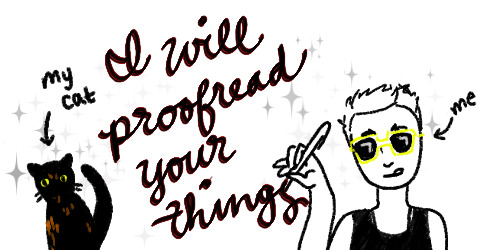
Hello, I'm your friendly neighborhood disabled unemployed transgender queer on the internet. I have not posted a great amount about the details on this blog for privacy reasons, but I am currently in an untenable familial/financial living situation, which I am actively working to get out of. My primary barrier to disentangling myself from the pertinent parties is a lack of income. I've been unable to pursue traditional means of work due to being multiply disabled (slash chronically ill, slash treatment-resistant, et cetera...), but I do not qualify for SSI or unemployment, so I am stuck trying to find other ways of making money.
This is where you come in... If you'd like to help, you can:
$$ Hire me $$ to proofread your fics, essays, and more!
Click below for info! (I also may add separate posts for diversity reading and/or other writing- and editing-related services.)
For $0.00855/word *OR BEST BID*, I will vet your work of writing before you publish it, checking for mistakes in spelling, capitalization, & punctuation, missed words, inconsistencies of tense, formatting, & POV, and miscellaneous grammatical errors. Never again need you fear posting a finished chapter and discovering a slew of typos after the fact; no matter how sleep-deprived or late at night the state of writing, I will ensure your text is ship-shape. Or, if you happen to be interested in having other types of writing proofread before submission--essays, comics or webtoons, letters, transcripts, compositions of a personal nature, so on--I will happily take these on at a comparable rate.[1]
Qualifications:
Bachelor's degree in English with a minor in writing
Initiate of international collegiate honors society for English scholarship, Sigma Tau Delta
Active member of the International Association of Professional Writers and Editors (IAPWE)
Former lit editor for award-winning university literary arts magazine
Prior employment in tutoring and teaching English, as well as copy-editing and content writing
Nearly 20 years' writing experience
Previous experience as both fic writer and beta
Incisive eye for typo-hunting and tenacious attention to detail (I have high standards and will make those everybody else's problem... now for pay!)
I will read for content of any genre and all ratings, and am broadly[2] open to any subject matter, kinks, et cetera. I'll also post more detailed guidelines (booking process, any exclusions, additional criteria) on a separate, unrebloggable post so that any edits and updates are always current.
Message me via the chat feature on Tumblr, or send me an e-mail (I will post it on my more info post) to request a quote, bid for a slot, or just to see what I can offer for whatever project you have in mind. And please feel encouraged to share or boost this post! I am in urgent need of any income I can get, and every share counts 😭🙌
. . . . . . . . . .
Proofreading Full Details · Other Services · Support Me (alternatively, Tip this post!)
- - - - - - - - - - - - -
[1] There will be some exclusions to this, such as academic assignments/papers that have style guide requirements; i.e., I will not be your online MLA style checker or anything.
[2] As with anything, there will be sporadic exceptions to this as well, but I will always be up-front about such cases.
#proofreading#fanfic#writing help#for hire#authblr#ficblr#writers on tumblr#writeblr#other tags??? idk help me out here#proofreading post#this is tumblr let's all pretend this post is as professional as it gets and that i don't have any obsessive compulsive disorders at all
69 notes
·
View notes
Text
Rewind the Tape —Episode 6
Art of the episode
Just like we did for the pilot and for episodes two, three, four, and five, we took note of the art shown and mentioned in the 6th episode while we rewatched it.
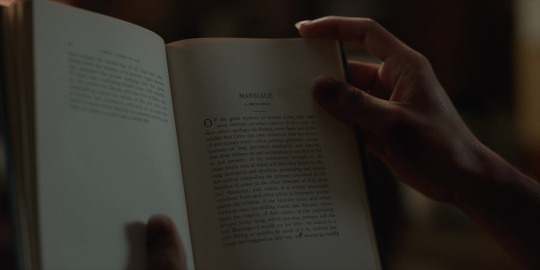
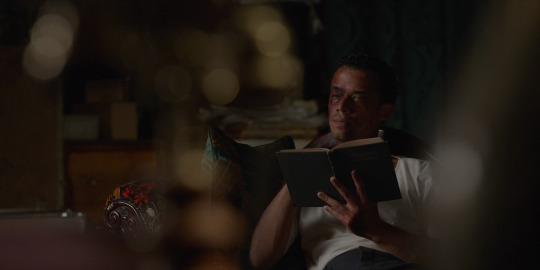
Love's Coming-Of-Age: a series of papers on the relations of the sexes
Edward Carpenter, 1896
Carpenter was an English writer and philosopher, and an early activist for gay rights and prison reform. In the opening of the episode, Louis is shown to be reading his essay "Marriage, a retrospective" you can read this essay, as well as the rest of the book, in the Internet Archive, here.

The Poems of Emily Dickinson
First collected and published in 1890
Dickinson was an American poet who published only ten of her approximate 1800 poems during her life.
Before her passing, Dickinson had asked her sister to burn her writings, and you can read more about how her sister Lavinia came to publish them instead, with major editions, in this LitHub piece.

Pelléas et Mélisande
Claude Debussy & Maurice Maeterlinck, 1902
Referenced in Lestat's lyrics, this is an opera in five acts about a love triangle, which ends in tragedy for both its titular heroes, the mysterious Mélisande and her husband's younger brother, Pélleas.
An interesting detail: after Pelléas and Mélisande's demise, they are survived by their daughter.
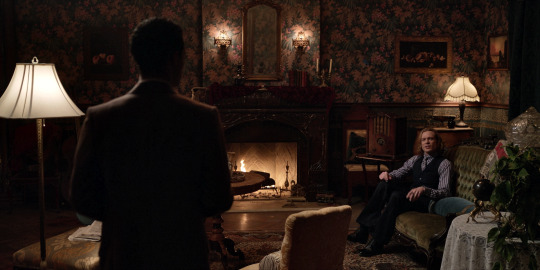

Three Peaches on a Stone Plinth
Adriaen Coorte, 1705
Coorte was a Dutch Golden Age painter of mostly small, intimate still lifes, and little is known of his life.
Still Life with Blue Vase and Mushrooms
Otto Scholderer, 1891
Scholderer was a German painter of portraits and still lifes, and was acquainted with another painter we've seen already, Manet.
Cumulus Clouds, East River
Robert Henri, 1901-1902
Henri was an American painter, first featured in episode one.
[All three identified by @diasdelfuego.]
After Lestat moves back into the house, new furniture, new decorations and new art appear all over, leaving little trace of the previous domestic violence (that is, except for the "reminders" that Claudia insists on keeping).

La Nausée
Jean-Paul Sartre, 1938
A recent release at the time of this scene, this novel by French philosopher Jean-Paul Sartre deals with an isolated and melancholy protagonist. [Identified by @saintarmand, here.]

Baby Strange
T. Rex, 1972
The song playing during Louis and Daniel's first meeting is by an English band, an early example of the glam rock genre.
If you spot or put a name to any other references, share via DM or in the reblogs, and let us know if you'd like us to add them with credit to the post!
Starting tonight, we will be rewatching and discussing the finale, ...The Thing Lay Still. We hope to see you there! And, if you're just getting caught up, learn all about our group rewatch here ►
#louis de pointe du lac#the vampire claudia#claudia iwtv#the titular vampire#spark in the dark#vampterview#interview with the vampire#iwtv#amc interview with the vampire#interview with the vampire amc#amc iwtv#iwtv amc#IWTVfanevents#rewind the tape#like angels put in hell by god#analysis and meta#art of the episode
30 notes
·
View notes
Text

Le Samouraï will be released on 4K Ultra HD + Blu-ray on July 9 via The Criterion Collection. Polly Dedman designed the new cover art for 1967 French neo-noir crime thriller.
Known in English as The Samurai, the film is written and directed by Jean-Pierre Melville. Alain Delon, François Périer, Nathalie Delon, and Cathy Rosier star.
Le Samouraï has been newly restored in 4K with HDR and uncompressed mono sound. Special features are listed below.
Special features:
Interviews with writer-director Jean-Pierre Melville and actors Alain Delon, François Périer, Nathalie Delon, and Cathy Rosier
Interviews with Melville on Melville editor Rui Nogueira and Jean-Pierre Melville: An American in Paris author Ginette Vincendeau
Melville-Delon: D’honneur et de nuit - 2011 short documentary exploring the friendship between writer-director Jean-Pierre Melville and actor Alain Delon
Trailer
Booklet with an essay by film scholar David Thomson, an appreciation by filmmaker John Woo, and excerpts from Melville on Melville
Alain Delon stars as Jef Costello, a contract killer with samurai instincts. After carrying out a flawlessly planned hit, Jef finds himself caught between a persistent police investigator and a ruthless employer, and not even his armor of fedora and trench coat can protect him.
Pre-order Le Samouraï.
#le samouraï#jean pierre melville#alain delon#criterion#the criterion collection#criterion collection#the samurai#dvd#gift#polly dedman#john woo#neo noir#crime thriller#french film#nathalie delon
15 notes
·
View notes
Text
Welp, I didn't expect to think about an old childhood favourite French comic series all of a sudden, and I figured I could make some fanart of it.

Have Jadina art everyone 🫴
Oh boy, where to start on the rendering style... I know how to draw in an anime style, but I feel so proud to achieve this particular one after so many years after my first attempts. Plus with some goddamn cool effects too! So happy!
Anyway, grab some food all of you guys who are Légendaires fans! 😊
(et pour les Français, voyez en dessous pour traduction si vous voulez)
Je pensais pas que j'allais revenir sur une de mes séries de bande dessinée préférées tout d'un coup, et je pensais faire de l'art avec un des personnages.
Donc voici Jadina!
Oh là, où commencer sur le style... Je sais comment dessiner dans le style d'anime, mais je suis tellement contente d'achever ce style particulier après plusieurs années depuis mon premier essai. Super heureuse!
En tout cas, prenez les miettes d'art des Légendaires pour tout ceux qui sont fans! 😊
#digital art#les legendaires#les legendaires fanart#fanart#carog art#carog does french stuff#jadina#jadina les legendaires
9 notes
·
View notes
Text
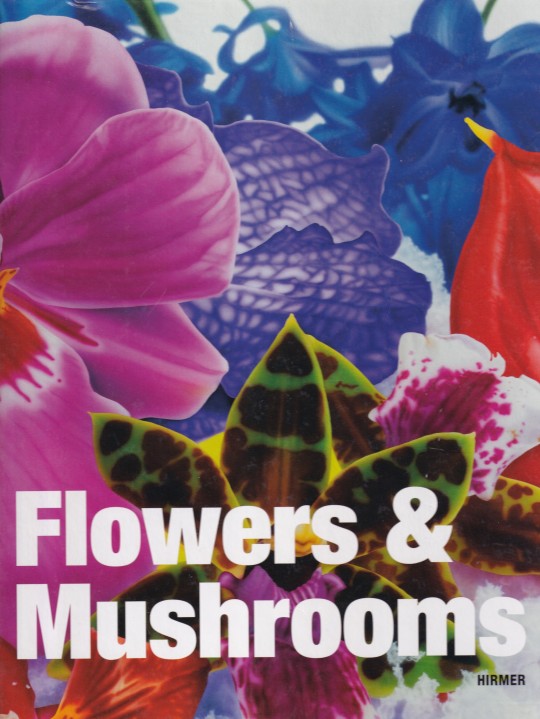






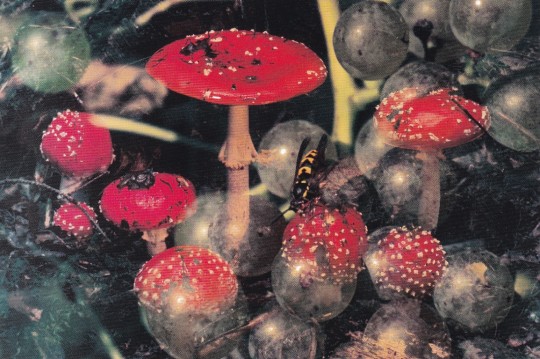


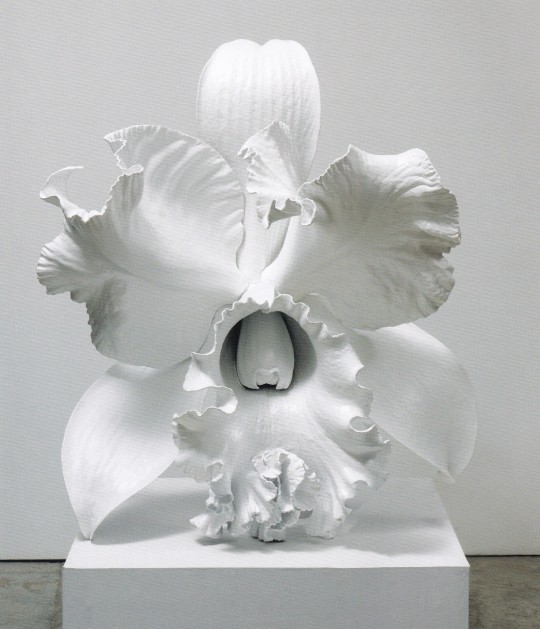

Flowers & Mushrooms
Essays by M. Harder, M. Moschik, T. Teufel, P. Weiermair, V. Ziegelmaier et al.
Hirmer Verlag, München 2013, 256 pages, 24x28,5cm, ISBN 9783777421605
euro 40,00
email if you want to buy [email protected]
Flowers and Mushrooms takes readers inside the rich and diverse symbolism of its eponymous subjects. Flowers have at times stood for freshness and fertility, transience and death. In addition to its ubiquitous and much-maligned image as a hallucinogen, the mushroom has throughout history signified health and life and served as an important symbol within religious ritual. In recent years though, flowers and mushrooms have become a focus in contemporary art, with artists manipulating the many clichés that surround them and adapting their representation to produce new and unexpected layers of meaning, from social criticism to feminism and the conceptual framework of the erotic. Among the leading plant portraitists are the Swiss duo Peter Fischli and David Weiss, whose series of forty photographs epitomize the potential to shed new light on familiar objects by presenting them in unusual context.
The exhibition at MdM Museum der Moderne - Salzburg presents works from Nobuyoshi Araki, Anna Atkins, Eliška Bartek, Christopher Beane, Karl Blossfeldt, Lou Bonin-Tchimoukoff, Balthasar Burkhard, Giovanni Gastel, Georgia Creimer, Imogen Cunningham, Nathalie Djurberg, Hans-Peter Feldmann, Peter Fischli/David Weiss, Sylvie Fleury, Seiichi Furuya, Ernst Haas, Carsten Höller, Judith Huemer, Dieter Huber, Rolf Koppel, August Kotzsch, David LaChapelle, Edwin Hale Lincoln, Chen Lingyang, Vera Lutter, Katharina Malli, Robert Mapplethorpe, Elfriede Mejchar, Moritz Meurer, Paloma Navares, Nam June Paik, Marc Quinn, Albert Renger-Patzsch, Zeger Reyers, Pipilotti Rist, August Sander, Gitte Schäfer, Shirana Shahbazi, Luzia Simons, Thomas Stimm, Robert von Stockert, William Henry Fox Talbot, Diana Thater, Stefan Waibel, Xiao Hui Wang, Andy Warhol, Alois Auer von Welsbach, Michael Wesely, Manfred Willmann, Andrew Zuckerman.
07/03/24
#Flowers & Mushrooms#exhibition catalogue#MdM Museum der Moderne - Salzburg 2013#Araki#Blossfedt#Gastel#Fischli/Weiss#LaChapelle#Mapplethorpe#Sander#Warhol#Haas#Nam Jun Paik#photography books#fashionbooksmilano
11 notes
·
View notes
Text
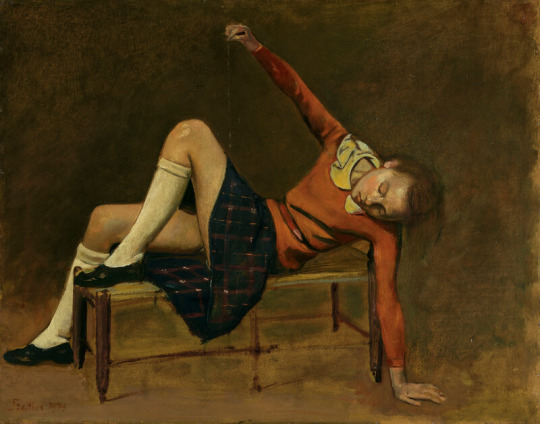
Balthus (1908-2001), Thérèse sur une banquette, signed and dated 'Balthus 1939' (lower left),
oil on board
Note: In late 1935 Balthus met Thérèse Blanchard, who lived several blocks from Balthus’s studio at 3, cour de Rohan. Thérèse’s appearance was unconventional, but she “had the grave and moody look that appealed to [Balthus],” writes Sabine Rewald, who selected the present work for the cover of the catalogue of the 2013 “Cats and Girls” exhibition at the Metropolitan Museum of Art. In his first portrait of Thérèse, painted in 1936 (Monnier and Clair, no. P 95), Balthus concentrated on her “serious mien” (exh. cat., op. cit., 2013, pp. 8 and 68). He similarly depicted her two years later (P 118; illustrated here). Thérèse sur une banquette, which dates from 1939, is the culminant image in what would be regarded as the most brilliant series of Balthus’s career, considered by Rewald to be “among his finest works” (ibid., pp. 7-8). “The paintings of Thérèse show Balthus at the apogee of his strength,” Nicholas Fox Weber has stated (Balthus, New York, 1999, pp. 388-389). Of Balthus’s ten portraits of Thérèse, five are acknowledged masterpieces, four of which are in museums. Thérèse sur une banquette is the fifth.
A sibling or school-mate posed with Thérèse for Frère et soeur in 1936 (Monnier and Clair, no. P 94). Her brother Hubert, two years older, appears with her in Les enfants Blanchard, 1937 (no. P 100); both their names are recorded on the reverse of the canvas. Picasso, by then the world’s most famous living artist, purchased the latter painting from the dealer Pierre Colle in 1941. “You’re the only painter of your generation who interests me,” Balthus recalls Picasso having told him. “The others try to make Picassos. You never do” (quoted in Vanished Spendors: A Memoir, New York, 2001, pp. 9-10).
Balthus last portrayed Thérèse in the present painting, seated on the banquette in which she appears in two earlier full-figure portraits (Monnier and Clair, nos. P 101 and P 112). At one time he envisioned a larger composition—perhaps on the scale of Les enfants Blanchard or even larger—the conception of which is known only from a loosely brushed study on a medium-sized board, painted earlier in 1939, Trois personnages dans un intérieur (no. P 122; sold, Sotheby’s London, 25 June 2009, lot 240). The three figures in the high-ceilinged interior—likely set in Balthus’s cour de Rohan studio—are Thérèse leaning back on the bench seat (as seen in the present painting), Hubert standing, his knee propped on a chair, gazing out the window, and their mother, Madame Blanchard, viewed from the side, resting in an armchair placed before a table. Three of four known preparatory drawings for this interior scene focus on Hubert.
Partly reclining on the banquette and turned to her left, Thérèsein the present painting dangles a string from her raised hand. In the smaller, three-figure essay, this string is attached to a ball. A kitten—not shown here—rears up and attempts to grasp the ball. In dispensing with the ball and cat in this picture, Balthus avoided the anecdotal distraction of the creature captured in stop-motion, as one might enjoy in a sentimental genre scene. The figure of the girl alone instead evokes a deeper sense of myth. Thérèse becomes an exemplar of l’éternel féminin, one of the ancient fates, said to measure and determine man’s thread of life.
In Thérèse sur une banquette, Balthus attended to the primarily professional, compositional concerns he had in mind—he aimed to depict the figure of his model in a novel, unique posture, one with neither a familiar nor apparent precedent. He moreover sought to evoke the inner world of her reality with a sense of presence that was outwardly and convincingly grounded in the mechanics of movement, while exalting the architecture of the figure. “The portrait of Thérèse on a Bench is caught in the sort of delicate balance that cannot last for more than a moment,” Jean Clair has written (V. Monnier and J. Clair, op. cit., 1999, p. 38).
Indeed, Thérèse displays the acrobatic ease and grace of the young girl saltimbanque in Picasso’s Rose period Acrobate à la boule, 1905 (Zervos, vol. 1, no. 290; Pushkin State Museum of Fine Art, Moscow). Balthus’s treatment of Thérèse recalls the gentle poetry of Picasso’s Rose period, even if rendered in a technique more like that of the 19th-century masters Courbet and Corot. A token of the rose tonality is here in evidence; “no reproduction can convey the unusual color of Thérèse’s sweater,” Rewald has commented, “which mingles red with shades of pumpkin and orange” (exh. cat., op. cit., 2013, p. 88).
Picasso surely appreciated Balthus’s mastery of the unusual pose, which lends Les enfants Blanchard, the painting he chose for his own collection, its visual novelty and charm, qualities that Thérèse sur une banquette shares with the earlier picture. Her poses in both pictures comprise a trapezoidal shape, which forms the base for a classic, Renaissance conception of a pyramidal composition. The pinnacle of this pyramid in the present painting is Thérèse’s upraised hand; in the room with her brother, his head in profile at the top center edge of the canvas. The artist also incorporates as a constructive means the diagonal emphasis characteristic of Baroque painting. Balthus invested the figures in both compositions with carefully plotted contrapposto, while also employing contrasts of bodily form with the geometry of furniture, and reiterations of formal elements, such as the arching of elbows and knees. From such imbalance and asymmetry Balthus created a configuration of parts that is sprawling and dynamic—yet stable, harmonized and whole.
Courtesy Alain Truong
69 notes
·
View notes
Note
Also -- and again this is something they'd know if they read your posts properly -- your problem isn't that people hyperfocus on characters and their dynamics; the common thread across a lot of your fandom meta is that "let people just fuck around and have fun, engagement with material and production of our own fan-made material don't have to be deep or meaningful" is incompatible with the mindset that fan-made works are of equal critical value to, and should be taken as seriously as, other media like classic literature. It's almost like these people only skim-read lengthy texts to get the gist of it and kind of approximate the author's points and beliefs based on that, or something...
also like you can goof off and have fun in a casual way with a piece of art outside of shipping. you do not have to write essays to demonstrate you “got the point” of your favourite show. people are also not structurally prohibited from not shipping anything. but the default fandom gaze is a shipping one, and if you eschew that for something else, if you think it’s not appropriate for a given work, you kinda don’t have an alternate space to express that! and people get really mad at you. and that’s not even getting into the racism et al I talked about. so even if you don’t want to insist fanfic is this deep subversive art form, even if it’s all pointless fun, the primary way to “have fun” online is to talk about ships, often ones that are not present in the text to begin with. WHICH IS FINE!!!!! but it’s the primary way fandom engagement occurs and that has limitations. and not everyone has fun that way!
37 notes
·
View notes
Text
New music themes for our main characters, starting with Tord. Hoping all subsequent pieces will be easier to make XP This one features a genre I never wrote in before, and a language I do not speak in and neither does Teto. Jazz said it is legible at the very least so, hooray. It's far from perfect and I hope Norwegian people can forgive me for that hahaha.
I'll be posting this, as well as "No Rest For The Wicked" (aka main theme) on my YT channel in July. Since I need some cover art for the music videos. Same will be true for the rest of the songs I'll write. Edd is next btw.
Like last time, lyrics and some ramblings under the cut
There was actually a different version of this song that I ended up completely scrapping as I couldn't come up with a chorus
My biggest sources of inspiration were early Korn, Slipknot and, surprisingly, "Ima's Tower", from The Void OST. The chromatic downstepping mostly. It really does create some angsty atmosphere. When I think about it, the characters themselves do have certain things in common, hm...
youtube
LYRICS
Dypt nede helt nederst
Av en endeløs grop,
Glemt og råtten,
Legger min ødelagte kropp.
(Deep down at the very bottom
Of an endless pit,
Forgotten and rotten,
Lays my broken body.)
En pendel uten snor.
Et verktøy, en gang så nøyaktig
Kan ikke gjøre en eneste sving
Med all makt stjålet.
(A pendulum without a string.
A tool, once so precise
Can't do a single swing
With all its drive stolen.)
I'm nothing but a shell.
(Trapped in a prison cell)
A ghost in the machine.
(Living off adrenaline)
Hope springs eternal,
But not for my chest.
Burning inferno
Is all I have left.
'Cuz I am no longer human.
Jeg er ikke lenger menneske.
I am no longer human.
Jeg er ikke lenger menneske.
Sigaretten min sin glør
Lyser i mørket,
Som jeg prøver å huske
Hvordan å puste inn.
(My cigarette's ember
Glows in the dark,
As I try to remember
How to breathe in.)
Lukter nitrat og svovel
Fyller luften.
Røyk og krutt
Legg igjen et hull i hodet mitt.
(Smells of nitrate and sulfur
Filling the air.
Smoke and gunpowder
Leave a hole in my head.)
I'm nothing but steel.
(It's all so unreal)
A cog in the wheel.
(YOUR PERFECT IDEAL)
Hope springs eternal,
But not for my heart.
Learn to comply,
And play your part.
Go metal!
THIS IS MY RIFFLE, THIS RIFFLE IS MINE!
THIS IS MY BURDEN, THIS BURDEN IS MINE!
Hope springs eternal,
And mercy divine.
Burning inferno,
And poison for mind.
I am no longer human.
Jeg er ikke lenger menneske.
I am no longer human.
Jeg er ikke lenger menneske.
Got nowhere to run,
Ingen steder å løpe
'Cus I was never human.
Jeg var aldri menneske
For the Norwegian parts, I've put italicized english translation in the brackets underneath. Except choruses cuz those just repeat the english lyrics.
Featured references and idioms:
First spoken verse is a reference to Edgar Alan Poe's "Pit and the Pendulum".
Ghost in the machine: Human consciousness and thought as an entity distinct and separate from the body.
Hope springs eternal in the human breast: People can always find a reason to hope, even in the bleakest situations. The phrase comes from Alexander Pope's poem Essay on Man.
Second spoken verse has words breath in and sulfur. This is in reference to Slipknot's song "Sulfur".
A cog in the wheel: Someone or something that is functionally necessary but of small significance or importance within a larger operation or organization.
This is my riffle, this riffle is mine: in reference to "Full Metal Jacket".
Mercy divine: not a direct idiom, but inspired by
to err is human (to forgive is divine)
Being fallible and making mistakes is inherent to being a human, and forgiving such mistakes is a transcendent act.
So it's mostly your typical nu metal angst XD Lots of parallels between being human and being a machine. Lots of self-imposed lies and false beliefs. Don't worry, we'll get 'em
#eddsworld au#eddsworld vtm au#music#emo tord era fr#volume warning? cuz u know...metal...#music to feel passive aggressive to#Youtube#as always answering the question in advance. made with fl studio and synthV#oh yeah this is technically his battle theme but i'm still deciding#if i should use this or just the instrumental
31 notes
·
View notes
Text

Essai d'une distribution généalogique des sciences et des arts principaux. Selon l'explication détaillée du système des connaissances humaines dans le discours préliminaire des éditeurs de l'Encyclopédie publiée par M. Diderot et M. d'Alembert, à Paris en 1751. Réduit en cette forme pour découvrir la connaissance humaine d'un coup d'oeil par Chrétien Frederic, Guillaume Roth, à Weimar, 1769
22 notes
·
View notes
Text


Within the first three decades after the end of the Second World War the majority of housing in basically all over Europe was constructed, a result not only of the repercussions of the war but also of growing prosperity, expanding welfare systems and a political will to improve the living conditions of the working and middle classes.
Together with students of TU Darmstadt Elli Mosayebi collected historic material of exemplary housing projects built between 1945 and 1975 with a particular focus on „second tier“ cities: Zagreb, Cologne, Oslo, Porto, Lyon, Athens, Liverpool, Manchester and Sheffield were selected precisely because they were less subject to overbearing avant-garde ideals and therefore able to develop more specific and ultimately more diverse housing projects. Of the initial 94 projects identified and researched 54 were finally selected for the present volume which represents nothing less than an interrelated archive of European postwar housing: „The Renewal of Dwelling: European Housing Construction 1945-1975“, edited by Elli Mosayebi and Michael Kraus and recently published by @triestverlag. For cross-reference the catalogue of the 54 projects is tagged with 6 thematic fields that allow for pan-European comparisons and also highlight shared characteristics like a hidden skeleton, refined materials or balconies as extended living space. Each of the cities is then discussed in an essay that provides additional context to the buildings documented: in the case of Cologne Jasper Cepl et al. for example discuss O.M. Ungers’ contribution to the „Neue Stadt“ Chorweiler within the context of his theory of the Morphological City and the city as a work of art, Anne-Kristin Kronborg on the other hand provides a thorough overview of Norway’s postwar housing, the welfare state and public-private partnerships.
In combination with the extensive documentation of each project the book really succeeds in providing a pan-European perspective on postwar housing that will hopefully inspire additional cross-border research with regards to housing and the political circumstances in which it came about. Highly recommended!
#housing#apartment building#architectural history#architecture book#triest verlag#monograph#book#postwarmodern
35 notes
·
View notes